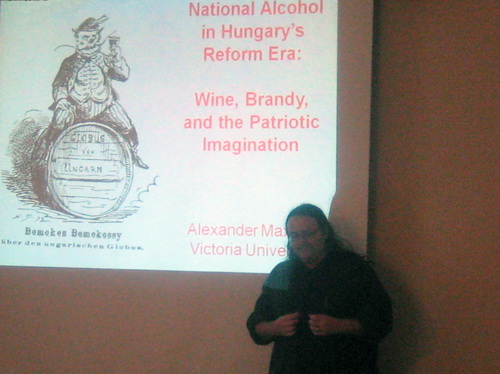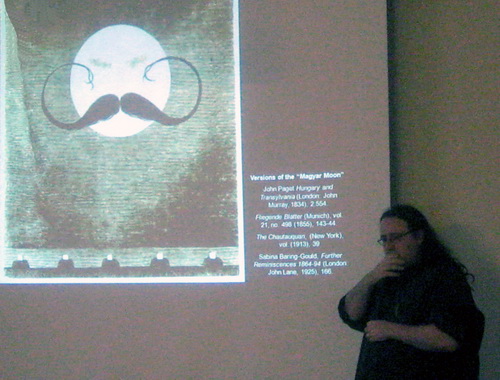 Dr Alexander Maxwell (Victoria University of Wellington, New Zealand) discussed the development of alcoholic culture in Hungary between 1825 and 1848. The paper represented part of a larger research project inspired by the stories of the traveller John Paget. The author studies behavioral forms of Nationalism in lifestyle, drinking habits, clothing, sexuality, facial hair, etc.
Dr Alexander Maxwell (Victoria University of Wellington, New Zealand) discussed the development of alcoholic culture in Hungary between 1825 and 1848. The paper represented part of a larger research project inspired by the stories of the traveller John Paget. The author studies behavioral forms of Nationalism in lifestyle, drinking habits, clothing, sexuality, facial hair, etc.
 Alcohol acquired important nationalist symbolism during the Hungarian Reform Era (1825-1848). Its symbolism derived partly from national self-glorification, but partly from the economic interests of Hungarian wine producers: patriots devoted great efforts to promoting the Hungarian wine industry. Characteristically, the inspcription on the bottle of the Tokaji wines is „Vinum regum, rex vinorum”, a slogan supported by a probably untrue story about Louis XIV’s enthusiasm regarding this wine. The praise of Hungarian wines was widespread even outside Hungary. However, travellers often told a diffenernt story, describing our wines as "undrinkable". Széchenyi, who as a patriot also promoted Hungarian wines, wishing that after his death his heart be put in Tokaji wine and placed in the building of the Nemzeti Kaszinó, is on a different opinion when acting as a reformer. According to him, the praise coming from foreign countries is false, since they do not want to buy the wines they speak so highly about. „Our wine, just like Hungarians, doesn’t bear movement”, he warns.
Alcohol acquired important nationalist symbolism during the Hungarian Reform Era (1825-1848). Its symbolism derived partly from national self-glorification, but partly from the economic interests of Hungarian wine producers: patriots devoted great efforts to promoting the Hungarian wine industry. Characteristically, the inspcription on the bottle of the Tokaji wines is „Vinum regum, rex vinorum”, a slogan supported by a probably untrue story about Louis XIV’s enthusiasm regarding this wine. The praise of Hungarian wines was widespread even outside Hungary. However, travellers often told a diffenernt story, describing our wines as "undrinkable". Széchenyi, who as a patriot also promoted Hungarian wines, wishing that after his death his heart be put in Tokaji wine and placed in the building of the Nemzeti Kaszinó, is on a different opinion when acting as a reformer. According to him, the praise coming from foreign countries is false, since they do not want to buy the wines they speak so highly about. „Our wine, just like Hungarians, doesn’t bear movement”, he warns.  There were concrete plans, too, to improve Hungarian viticulture, e.g. by Franz Schams who advised the systematizing of grape varieties or Elek Fényes, who spoke up against the too many liquid measures.
There were concrete plans, too, to improve Hungarian viticulture, e.g. by Franz Schams who advised the systematizing of grape varieties or Elek Fényes, who spoke up against the too many liquid measures.
While the production of brandy also grew during the Reform Era, Hungarian elites associated the characteristically Slavic tipple with drunkeness and disorder. Interestingly, the Slovak temperance movement became a national question, as they connected the fight agains drunkenness with the resistance against Hungarians and Jews. In Hungary, however, the temperance movement was simply a public health issue.
Alcohol’s cultural symbolism thus reflected Hungary’s ethnic diversity: different alcoholic beverages associated with different ethnic groups inspired different attitudes from Hungarian elites.
András Péterfi


